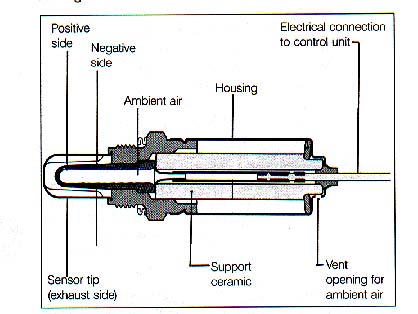20V Motronic ECU System
1991 200TQ and 1992-95 S4/S6 with 20V Turbo Engine
O2 SENSOR - TESTING
If the O2 sensor signal wire is disconnected, the ECU usually has a 0.450 V (+/-
0.050V) reference voltage on this wire connecting to the O2 sensor when the engine
is running. The ECU will switch over to a basic idle mixture setting with the
O2 sensor disconnected [1] If you suspect the O2 sensor is causing a running/driveability
problem, you can temporarily disconnect the sensor and drive the car to see if
the problem still exists.
The system is designed to operate without the O2 sensor connected and the engine
will run fine assuming the other systems/components are functioning properly.
You should clear the ECU memory after disconnecting the O2 sensor, in case the
ECU adaptive mixture control has been corrupted by the faulty O2 sensor.
Please also note that disconnecting the O2 sensor will store a fault code in the
ECU that may need to be cleared after reconnecting the O2 sensor. The ECU O2 signal
wire is the large green wire with male spade connector under the small rubber
boot.
The Single Black wire with spade connector from the O2 sensor connects to this
green wire. The 1991 200TQ's and 1992-95 S4/S6 with 20V Turbo engine have this
rubber boot connection on the back engine firewall area on the bracket below the
other color coded connectors.
VAG 1551/2 TESTING If you have the VAG1551 or VAG1552 Scan tool, or the VAG COM
PC emulation software with interface and adapter cables, you can view the internal
Motronic ECU block data values for the O2 sensor. The engine should be warmed
up (oil temp at least 185F, 85C) and the A/C turned off along with any other electrical
items. Function 04 allows the viewing of the 10 channels of data.
Channel 8 shows the O2 sensor control values, and these should be oscillating
up and down between 123-133 after the engine has been running for 2 minutes. Channel
9 shows the O2 sensor adaptation values and this reading should be between 115-141.
The Bentley manual section D2-440-1 (Diagnosis, Fault Memory) for the 1991 200TQ
20V has addition details on troubleshooting when the values read are outside these
ranges. For the 1992-95 Audi S4/S6, Bentley section J01-52 has additional details.
Audi parts on-line catalog
DMM TESTING
You can also use a Digital Multimeter (DMM) to do a basic test of the O2 sensor
voltage with the sensor connected to the ECU, but the meter normally will not
respond quickly enough to see the voltage go up and down. It is important to know
what the input impedance is of the meter you are connecting across the O2 sensor
or for that matter across any of the ECU inputs/outputs.
Most modern DMM's have a 10 Mega-ohm input impedance. Many of the older analog
meters have a input impedance down below 100K ohms. These older meters "may"
work once your O2 sensor is warmed up as the impedance of the O2 sensor usually
drops to 5-20k ohms.
If your DMM has a "analog" type bar graph feature, you can measure the
O2 voltage and see changes, as this bar graph display responds quicker and this
can be used to monitor the O2 sensor voltage as it swings high and low when the
ECU/fuel system is in closed loop operation. If the DMM has a "zero"
feature to zero out the bar graph reading with a voltage applied, you can connect
the DMM to the O2 sensor wire and turn on the ignition before starting the warm
engine.
The DMM should read ~0.45V with the meter connected to the O2 sensor wire with
the ignition on, but with the engine not running. Now zero out the 0.45V reading,
and start the engine. The DMM bar graph should oscillate up and down around this
0.45V reference voltage 1 to 2 times per second, indicating that the system is
in closed loop operation.
OSCILLOSCOPE TESTING
One test you can do with the O2 sensor wire connected to the ECU, is to use
an oscilloscope to measure the O2 sensor voltage and then force the mixture
rich with the slow addition of propane into the intake system. The O2 sensor
voltage should rise up to at least 0.85 volts.
Then force the mixture lean by creating a huge vacuum leak and measure the O2
voltage transition time when the voltage drops from high to low. To quickly
force the mixture lean, you can pull off a large hose from the intake manifold.
This will make the engine stall but you can capture the O2 voltage response
on the digital oscilloscope.
Typical transition times are around 25-50ms, the rule of thumb is that the O2
sensor transition time from 0.6V to 0.3V or from 0.3 to 0.6V should be under
100ms. The O2 sensor will have a different transition time going from rich to
lean than from lean to rich, if I remember correctly the rich to lean transition
is slightly longer.
It is important to understand that if the VAG 1551/2, the DMM, or the Oscilloscope
shows the O2 sensor voltage stuck high or low and not oscillating up and down,
that the sensor may be working correctly. The real problem may be mechanically
related (lean condition from vacuum leak) or engine fuel system may have a problem
(rich mixture from fuel pressure being too high).
When the engine is running very lean (low O2 voltage) or is running very rich
(high voltage) the ECU can not tweak the mixture enough to compensate for these
problems. The O2 sensor heating element could also be defective, and this can
cause a cold O2 sensor at idle with no fluctuation in output voltage.
O2 SENSOR PROBLEMS One problem that affects the O2 sensor operation is contamination
or poisoning by silicone, this shows up as a fine white powder on the tip of
the sensor and will reduce the voltage output of the sensor when the mixture
is rich, and this will cause a loss of fuel economy and increased CO and HC
emissions.
You may also see a negative voltage developed under lean operation when the
sensor is poisoned by silicone. This poisoning causes the sensor to see a lower
proportion of Oxygen. The slots in the tip of the O2 sensor can also get partially
clogged with carbon which will increase the response time. This will cause the
O2 voltage change to slow way down, taking 3-4 seconds to go up and down, instead
of changing in less than a second.
This slow response can cause a varying idle speed and varying idle mixture.
The exhaust gas Carbon Monoxide (CO) reading will not be steady at idle when
read by an exhaust analyzer. This can also cause some light surging under light
acceleration with the engine cold and when fully warmed up under cruise conditions.
There are several Society of Automotive Engineers (SAE) articles that have been
published since the early 70's that describe in the utmost detail the operation
of these O2 sensors.
Here is a photo showing some details on the O2 sensor construction.

Diagram courtesy of Robert Bosch Corporation
Here is an excerpt from the 1976 SAE article #760287
"Closed Loop Control of Lean Fuel-Air Ratios using a temperature compensated
Zirconia Oxygen Sensor"
"The sensor is based on the electro-chemical potential developed across a zirconium
dioxide solid electrolyte when its two electrodes are exposed to differing oxygen
concentrations. One electrode is exposed to the constant oxygen pressure of
ambient air and the other to the oxygen pressure of the exhaust gas which varies
with equivalence ratio. A voltage is produced which is a function of the equivalence
ratio."
Most university libraries have the articles going many years back on micro-fiche
and they should have an index that lists all the articles by subject, author
and number.
Go to O2 Sensor and Emission Article Listing
for details.
20V ECU system information index
Audi parts on-line catalog
References: [1] Audi of America, Technical service training publication:
"The New 20V Turbo Engine for the Audi 200 Quattro-publication All rights reserved.
Copyright © SJM Autotechnik™ , all rights reserved
Return to
Troubleshooting Tips page.
Return to
SJM Autotechnik™ main page.

